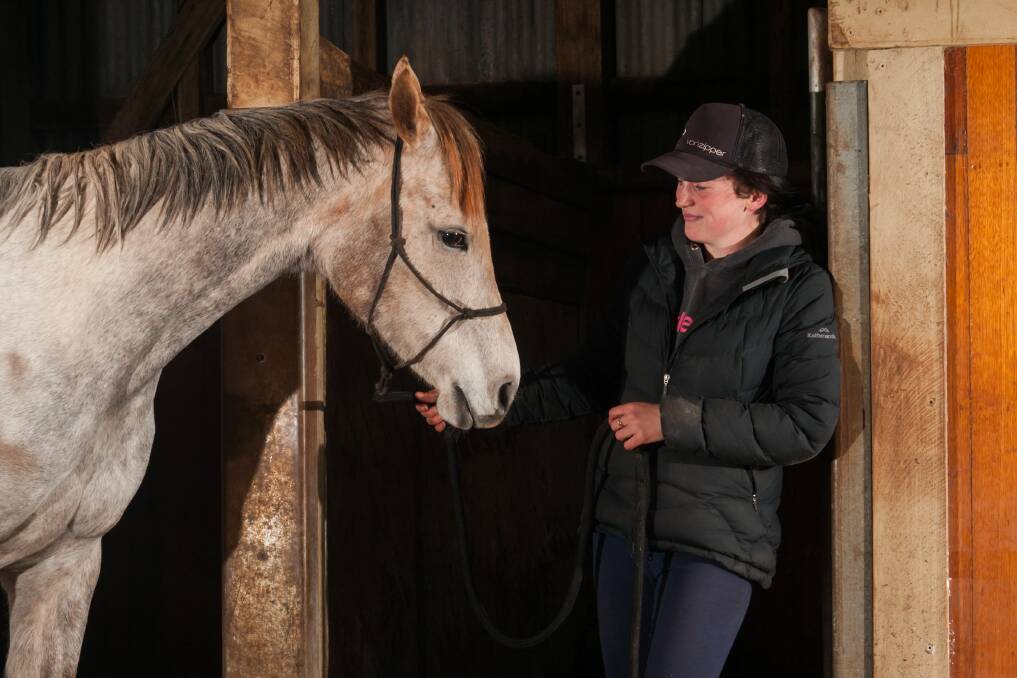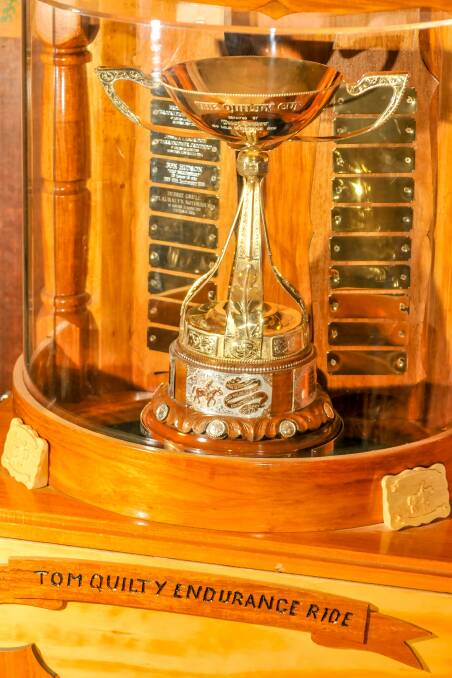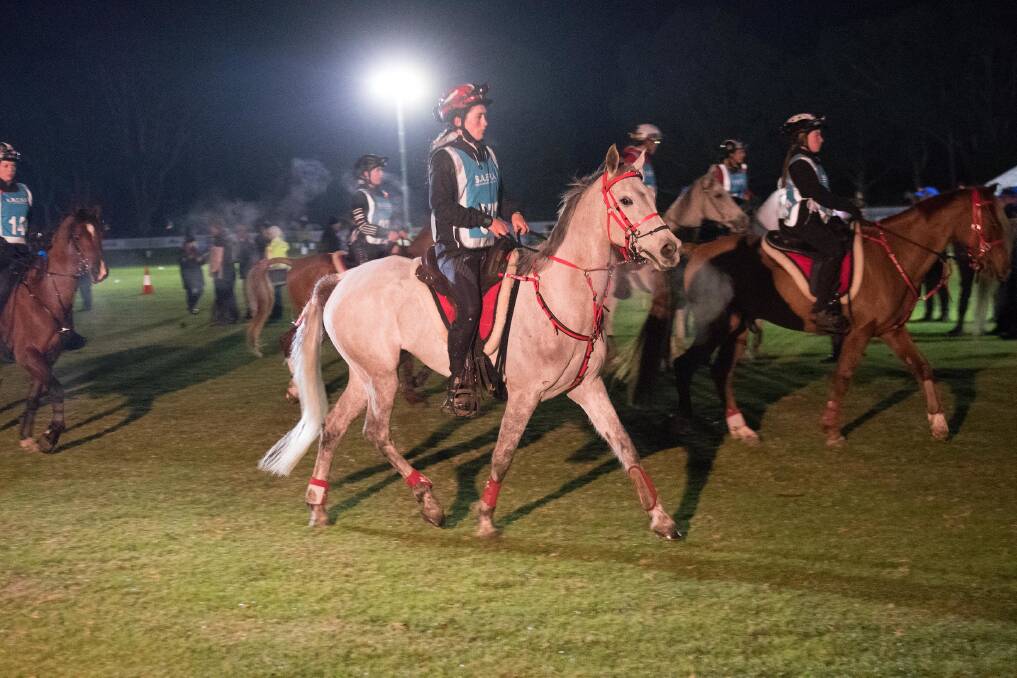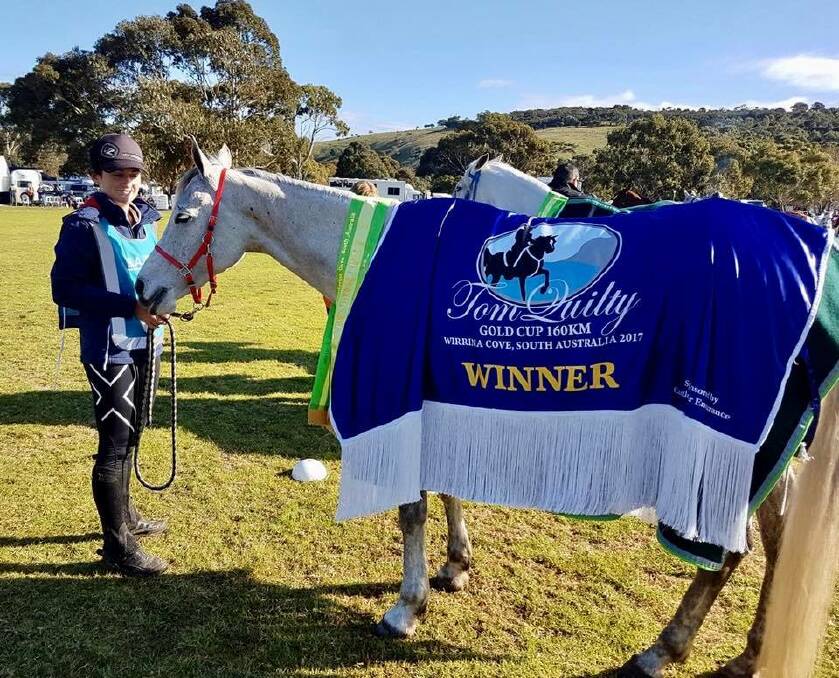
It’s midnight, but the night isn’t quiet.
Subscribe now for unlimited access.
or signup to continue reading
Under a cold winter sky in Wirrina Cove, South Australia, a swirling mass of horses and people are preparing, lining up to start the ultimate test of equestrian endurance.
This is the Tom Quilty Gold Cup: riders and horses are faced with a gruelling 160 kilometres of challenging tracks, across all terrain, in all weather, for the ultimate prize of the Quilty trophy.
At the end of each stage, they have to go through a rigorous, impartial vetting process to ensure each horse is fit and well to continue the next.
In Australia’s outback heritage the icon of horse and rider rings through literature and culture – the Man from Snowy River, the drover and his dog, Phar Lap and Jim Pike, the yearly spectacle of racehorse and jockey striving for the Melbourne Cup.
And the Tom Quilty is made of the same stuff of legend.
The race was created in the late 1960s by RM Williams, who wrote to horseman Tom Quilty asking for support creating a long distance horse race. From that letter came an annual endurance race and the birth of an amateur sport.
To finish a Tom Quilty, regardless of placing, is to win, with just the satisfaction of gaining a highly coveted Quilty buckle.
There’s no prize money allowed in Australian endurance riding – riders take part for the love of testing themselves and their horses against their own times, against the elements, and each other.
The midnight start launches the hopes of more than 150 riders, including several international riders joining the challenge.

By daylight, in just 10 hours, 28 minutes and 40 seconds, Brooke Brown-Cordell and Tierview Salama become the winners of the 2017 Tom Quilty.
Brown-Cordell, 20, is no stranger to the endurance scene: she’s been riding almost before she could walk and is now full-time trainer working for Jared Pickering at Vandieman Arabians, based in Lebrina.
But to win the Tom Quilty? “It still hasn’t quite sunk in yet.”
Brown-Cordell’s success follows that of other Tasmanian riders – in 2016 the Quilty was won by Debbie Grull on Lauralyn Notorious, who returned to take out equal second middleweight this year.
Fellow Tasmanian Bella Pickering won the junior division, while the Tasmanian state team came first in their competition.
The Tom Quilty visits a different state annually, giving all riders the chance to compete without having to travel interstate.
“This year's state champs are a test event for next year's Tom Quilty because it's going to be held in Tassie in October [2018],” Brown-Cordell said.
“We’re only taking young ones this year, all our seasoned experienced horses went to the Quilty and are having a well-deserved rest.”
Now in the quiet of home, Tierview Salama is enjoying some time away from the tracks, while Brown-Cordell continues on with her next challenge – preparing the young and inexperienced horses for the state championships in October.
In 2012, the Quilty was hosted at St Helens: in 2005, Sheffield, and in 1999, Deloraine.
Next year, the Quilty returns to Tasmania’s North East, to Santarena Park between Scottsdale and Bridport, in October.
As the Quilty tours Australia, each state and territory hosting it must provide the 160-kilometre track a year ahead of schedule, so riders and horses have a chance to familiarise themselves with the challenges ahead.
Usually the Tasmanian state championships are held in November, but this year were brought forward to October to better mimic expected conditions when the Quilty rolls over the same tracks next year.
Graham Bucknell is the president of the 2018 Tom Quilty committee. He began planning for the Quilty’s return in late 2015.
Bucknell said Scottsdale was “particularly welcoming” to the ride, with years of endurance history made in the North and North East.

“We’re getting fantastic support from the people in Scottsdale, because Scottsdale was where the first endurance ride in Tasmania was held, in August ‘75,” he said.
“Endurance was so established in the old days, in Scottsdale and the North East.
“We’ve had some characters through the times.”
The tracks being combined to form 160 kilometres of the ultimate endurance test cover some familiar country for the region’s own, and some new challenges for an expected 20-odd interstate riders expected for the state championships.
“It’s undulating country, there’s a couple of largeish hills in it, there’s some road and some bush tracks,” Bucknell said.
“We go through a couple of farm properties, from one of the places we can see Bridport, so we get up pretty high out toward Scottsdale.”

For a sport that has little in the way of cash prizes, and is rarely heard of outside of equestrian circles, the dedication required is huge.
“When we do one Quilty, after that’s finished it’s pretty much planning for the next one,” Brown-Cordell said.
“You get home and you may not be necessarily doing something towards it, but you’re thinking about it, and planning it.”
Horses, almost exclusively Arab or part-Arabs favoured for their stamina and endurance, are trained to peak physical fitness over months of patient riding and training.
It’s highly technical, going far beyond throwing a saddle on and hitting the tracks, with full plans for each horse of which local rides they will compete in during the year to prepare for the major rides, both in Tasmania and interstate.
Long months of training in rain, hail or shine, working with your horse for months to prepare for an 80 or 90 or 160 kilometre ride – only to be vetted out halfway through.
“I think it’s the challenge, because … if you’re just an ordinary person whose riding and enjoying it, you’re competing against yourself,” Bucknell said.
“Some people may have done a 160 [ride] and they get vetted out at the last vet check.”
But to do so, you have to know your horse well, establishing the bond of trust and instinct that comes with years of patience and training.
Brown-Cordell has only been riding Tierview Salama – or Sally – for about a year, but horse and rider already know each other well.
Returning from South Australia, the Arab mare has become quite pushy, bossing around her paddock mate and ensuring every horse on the property knows she’s the queen.
“She knows she’s done well,” Brown-Cordell said.














